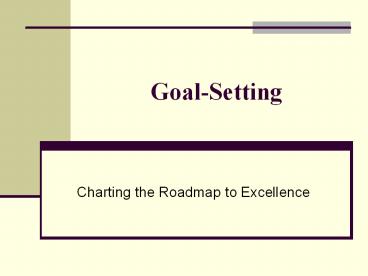Goal-Setting Charting the Roadmap to Excellence Perspectives - PowerPoint PPT Presentation
1 / 19
Title:
Goal-Setting Charting the Roadmap to Excellence Perspectives
Description:
Goal-Setting Charting the Roadmap to Excellence Perspectives on goal-setting Setting goals is the first step in turning the invisible into the visible. – PowerPoint PPT presentation
Number of Views:101
Avg rating:3.0/5.0
Title: Goal-Setting Charting the Roadmap to Excellence Perspectives
1
Goal-Setting
- Charting the Roadmap to Excellence
2
Perspectives on goal-setting
- Setting goals is the first step in turning the
invisible into the visible. Anthony Robbins - A goal properly set is halfway reached. Abraham
Lincoln - People with clear, written goals, accomplish far
more in a shorter period of time than people
without them could ever imagine. Brian Tracy - Without goals, and plans to reach them, you are
like a ship that has set sail with no
destination. Fitzhugh Dodson - Progress has little to do with speed, but much to
do with direction. Author Unkown
3
In the workplace, goal-setting is a valuable tool
that
- Enhances productivity
- Encourages on-going communication and
collaboration between employees and supervisors - Stimulates long-term vision and short-term
motivation - Adds credibility and objectivity to performance
evaluations - Helps to align employee and unit goals with
strategic employer objectives
4
Goal alignment at the University
UD Strategic Plan
College/Division Goals
Unit/Department Goals
Employee Goals
5
Goal-setting components
- Goal statement of results to be achieved within
a specific timeframe - Standard ongoing performance criteria to be
repeatedly met or exceeded - Competency personal attribute, ability or skill
an individual demonstrates at work - Stretch Goal extremely ambitious goal that
prompts outside-the-box thinking
6
Variety is good! Consider a combination of
- Goals and standards that support unit objectives
- Goals that support personal/professional
development - Stretch goal that is very rigorous and challenges
talents and abilities
7
Motivational benefits of goal-setting
- Setting specific, challenging goals helps to
increase job satisfaction and performance. - Feedback helps employees understand what they
should continue doing, stop doing, or start doing
to attain the goal. - Maintaining goal commitment is important, e.g.,
focusing on outcome expectancies (how my actions
affect the goal) and self-efficacy (the belief
that I can achieve it). - Resources (especially employee training and skill
development) should be made available and
obstacles removed. - Gary P. Latham , Motivate Employee
Performance through Goal-setting
8
Job Description the foundation for goals,
standards and competencies
- Job descriptions support goal-setting
- Is the description current and relevant?
- Does it encompass major duties and
responsibilities? - Are expectations clearly defined?
- Out of date? Then update!
9
Create S.M.A.R.T. goals
- Specific precise and detailed
- Measurable with criteria for determining
progress and success - Achievable attainable and action-oriented
- Realistic relevant and aligned
- Time-related grounded within a time-frame
- Peter Drucker, The Practice of Management
10
Is it specific?
- Greater chance of achieving specific rather
than general goals - Clearly defined why? what? when? how?
- Written and detailed
- Example
- General Lead a healthier lifestyle in 2008
- Specific Improve health by exercising 3
hours per week and by losing 30 pounds by - December 31, 2008
11
Is it measurable?
- If you cant measure it, you cant manage it!
- How much? How many? When?
- Observable or trackable results
- Relevant benchmarks or metrics to assess progress
and attainment - Example
- While 30 lbs and 3 hours/week is easy to
measure, more relevant measures of health
improvement may be changes in blood pressure,
cholesterol or percent body fat.
12
Is it achievable?
- Likelihood of success
- Attained with a reasonable amount of effort and
application - Possess (or can develop) the abilities, skills or
knowledge to attain - Example
- Achievability can be improved by developing
knowledge of weight loss methods (e.g., Weight
Watchers) and fitness programs (e.g., Employee
Fitness Center)
13
Is it realistic?
- Practical and manageable
- Relevant to individual and organization
- Necessary resources are available
- Flexible vs. rigid
- Example
- Rigid requirements can weaken motivation.
Exercising 3 hours weekly rather than ½ hour
daily for 6 days/week is more flexible and more
realistic for some.
14
Is it timely?
- Anchored within a time frame
- Start date, finish date and/or deadline
- Averts procrastination
- Timing can impact attainability
- Example
- Losing 30 lbs in 12 months is reasonable.
- Losing 30 lbs in 1 month is unreasonable.
15
Tips for interactive goal setting
- Clearly state the performance goal or standard
- Break it down into manageable components
- Isolate resources needed to accomplish each
component - Identify possible barriers
- Develop a timeline (e.g., quarterly) to meet and
review progress
16
Need to knows for supporting goal achievement
- What skills are needed?
- What information/knowledge is needed?
- What help/collaboration is needed?
- What resources are needed?
- What might block progress?
17
Regular check-ups are critical!
- Supervisors should regularly review goal progress
with their employees - Dialogue keeps goals fresh and on track
- Milestones can help to sustain motivation
- Changing needs, priorities and resources may
require goal adjustment, postponement or addition
of a new goal
18
How can supervisors revitalize UDs performance
appraisal process?
- Ensure 100 percent participation
- Engage in interactive goal-setting
- Regularly meet with employees to discuss progress
toward goals (quarterly is recommended) - Strengthen the correlation between employee
performance and distribution of merit raises - Identify and reward exceptional performance
19
Resources for goal-setting and performance
evaluation
- Human Resources
- http//www.udel.edu/EMPRELATION/appraisal.html
- Morris Library
- Other colleges and universities
- Internet
- For help with job descriptions, contact
HR-Classification at - 831-2171 or hr-class_at_udel.edu.































